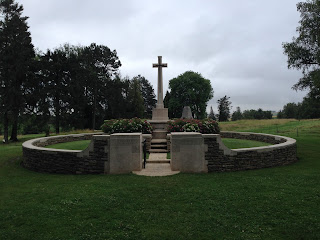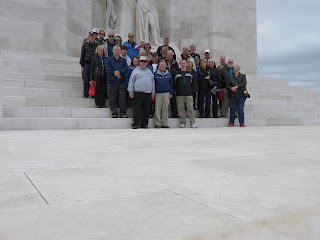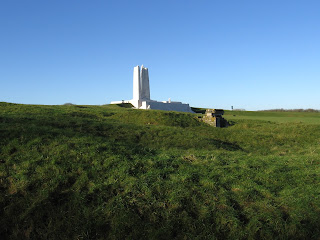 Our exploration of the Somme battlefields began at Beaumont-Hamel, well-known as the site of the destruction of the Newfoundland Regiment on the first day of the battle. 1 July 1916 was the costliest single day in all of British military history. Roughly 20,000 men were killed out of an approximate total of 60,000 casualties from the various British and empire units. The Newfoundland Regiment, part of 29th British Division, lost 324 killed and another 386 wounded here, leaving just 68 men to answer roll call the next day. After the war the Newfoundland government purchased the site, along with four other battle sites in France and Belgium, to commemorate the colony's contribution to the Allied cause. These sites are now marked by the caribou memorial. Newfoundland, of course, did not join Canada until 1949, and July 1 is still observed there as Memorial Day.
Our exploration of the Somme battlefields began at Beaumont-Hamel, well-known as the site of the destruction of the Newfoundland Regiment on the first day of the battle. 1 July 1916 was the costliest single day in all of British military history. Roughly 20,000 men were killed out of an approximate total of 60,000 casualties from the various British and empire units. The Newfoundland Regiment, part of 29th British Division, lost 324 killed and another 386 wounded here, leaving just 68 men to answer roll call the next day. After the war the Newfoundland government purchased the site, along with four other battle sites in France and Belgium, to commemorate the colony's contribution to the Allied cause. These sites are now marked by the caribou memorial. Newfoundland, of course, did not join Canada until 1949, and July 1 is still observed there as Memorial Day.The 29th Division's front line trench at Beaumont Hamel. The Newfoundlanders had been forced to advance overland from their support position in the second line (the St. John's Road trench, as it was called). Few of the men made it beyond this point.

The ground in the Somme region features rolling hills, unlike the predominantly flat terrain around Ypres. The Newfoundland memorial park at Beaumont-Hamel features one of the largest and best-preserved sections of the battlefield remaining to us, so it is a little easier to envision the course of the battle here than at most other sites.
German lines at Beaumont-Hamel incorporated a formidable obstacle called the Y-Ravine, a feature which lent its name to this cemetery on the grounds of the park where many of the fallen Newfoundlanders were buried.

In November 1916, the 51st (Highland) Division finally captured the German trenches which were the initial target on the first day of the battle. The division is commemorated at the back of the park.

Hunter's Cemetery is one of the more unique Commonwealth War Graves Commission cemeteries in Europe, and one of a relatively small number of mass graves.


From Beaumont-Hamel we moved on to visit the Thiepval memorial to the missing of the Somme. Similar to the Menin Gate in Ypres, the Thiepval memorial lists the names of 72,000 British Empire troops who fell in the Somme battles and who have no known grave.

The cemetery beside the memorial contains graves from both the British and French armies, thus honoring the wartime alliance.
We stopped for lunch in Albert, a key town held by the Allies throughout most of the war. The church was a notable landmark for British troops moving to the front, particularly because of the damaged statue of the Virgin Mary. The church had been damaged by shelling in 1915 and the Virgin leaned parallel to the ground. Soldiers being somewhat superstitious, it was said that the war would end when the Virgin fell. It finally did fall in April 1918 (a consequence of British shelling after the Germans took the town during their spring offensive), but the war of course carried on until November. The church and the sculpture were rebuilt according the original plans after the war.


Our next stop was the Historial de la Grande Guerre, a museum in Peronne. The Historial has a good collection of artifacts that helps to illustrate what we read in the history books. One of the reasons why the French army lost so many casualties in the war's opening months was the high command's belief in the power of the offensive spirit, morale, and esprit de corps to conquer the enemy. Colourful uniforms were a reflection of their pride, and of course they illustrate perfectly the argument that the generals were fighting a 20th century war with 19th century ideas. These uniforms would not have been out of place in Napoleon's day, when soldiers needed to be highly visible to their commanders on a battlefield shrouded with smoke. Such visibility was fatal on battlefields dominated by machine guns like the ones at left.

The French had actually ordered the less-conspicuous horizon blue uniforms, seen here, before the war broke out, but they had not arrived before the Battle of the Frontiers cost them 329,000 casualties in August and September 1914.


 The Germans, of course, had their feldgrau, or field grey, uniforms. They seem to have learned earlier than the French (so did the British), having adopted this colour in 1907.
The Germans, of course, had their feldgrau, or field grey, uniforms. They seem to have learned earlier than the French (so did the British), having adopted this colour in 1907.When we talk about the Somme, we usually mean 1916. But of course there was fighting over much of the same ground throughout the rest of the war, and particularly in 1918. After the 1916 battles ended in late autumn, the Germans stepped back to prepared positions at the Hindenburg Line. In the spring of 1918, however, they retook all of the territory they had given up and more. They advanced beyond the old 1916 front lines towards the key rail centre of Amiens before exhaustion compelled them to stop, and it was the Battle of Amiens in early August 1918 that inflicted a defeat on the Germans from which they could not recover.
The British attack at Amiens was led by the Canadians and the Australians, and here at le Quesnel we saw another of the standard granite Canadian memorials. The Canadian Corps advanced eight miles on the first day of the battle, 8 August 1918, the greatest single-day Allied advance to that point in the war.
The Australian contribution to the fighting on the Western Front is commemorated near Villers-Bretonneux, on their startline for the Battle of Amiens. This is their equivalent of our Vimy Ridge memorial, with the names of 11,000 Australians inscribed who fell in France and have no known graves.

The Villers-Bretonneux Australian memorial includes a Commonwealth War Graves Commission cemetery, seen here from the top of the memorial tower.

Villers-Bretonneux is largely an Australian cemetery but it is also the resting place for a number of Canadians. Probably the most notable is Victoria Cross winner Jean Brillant of the Royal 22nd Regiment.

Our hotel in Amiens was a very short walk from the magnificent cathedral, one of the largest in western Europe. During the summer months, the cathedral is the focus of a spectacular sound and light show which illuminates the statues on the façade, revealing what the painted face of the cathedral may have looked like in the medieval period. Unfortunately, our tour passed through Amiens in mid-May, too early to see the show, which only begins in June.

I took these next two photos in July 2014 during last year's tour.


































